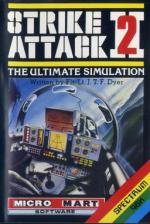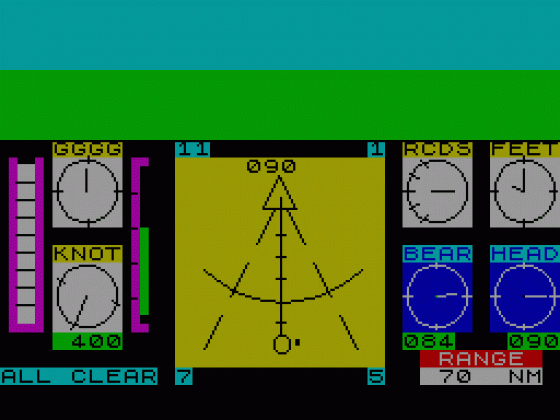Strike Attack 2
Micro Mart have released an improved version of their earlier Strike Attack game.
The program is a cockpit simulation game, which relies entirely on instrument guidance. You are the Navigator/Weapons Systems Operator (WSO) of a Strike Attack aircraft en route to its target. The run starts off at 10.000 feet heading 0900 at 400 knots. The target is within a range of 70nm. The aim of the game is to stay alive long enough to reach the target and score a hit. The main defence instrument is the Radar Warning Receiver (RWR) which informs you of any attacks from enemy fighters, Anti Aircraft Artillery (AAA) Surface to Air Missiles (SAMs), the enemy is not to be engaged. The main defence consists of evasive action, breaking hard left or right (4 to 6g force should get your blood stirring!) and changing altitude.
Controls
The cursors control the general motion of the aircraft, left and right turn, rate of climb/ descent. The program is not an arcade style game, as it is written in Basic. The response to any input and the display update take several seconds. This requires keys for hard turns of 4 and 6g (breaks). To defeat an attack, a break is required to shake off any enemy plane or missile. Speed is controlled by increasing or decreasing the throttle setting or activating the air-brake. The final target run requires 2 degree adjustments left or right. After a successful attack evasion 'Y ' will level the wings and reduce all rates of turn to zero. The 'pickle button', which Is the bomb release is represented with key B.
Instrumentation

The main instrument is the Radar Warning Receiver, which is simulated by flashing symbols in the appropriate clock positions around the map/position display. The map displays the bearing sector of 060 to 120 degrees for the attack and your position is displayed by a marker. The set of instruments include an altimeter, RCDS (Rate of Climb or Descent) meter, bearing and heading indicators, a range to target indicator, throttle setting, airspeed indicator, G-force meter and the fuel meter. The cockpit view acts as a horizon meter with a green ground and cyan sky.
The Game
On start-up a menu displays three choices. Training mode, which allows you to continue even after being hit by enemy fire, Range practice, which leads you straight to the final 7nm bomb-run (avoiding any attacks from the enemy) and Fully operational, which drops you into the deep end of the matter, the real strike attack. The probability of an attack depends on the flight altitude taken, so it is best to level off below 2000 feet. The approach up to 50nm of the target is riddled with enemy fighter attacks. The approach line will consist of breaks to port or starboard, a break lasting as long as the attack itself. By the time you have weaved yourself within the 50nm range, you will be pleased to know that you will only need to dodge AAA or SAM attacks. The MA attacks will require a change of altitude to disrupt the artillery range setting. When the range falls below 7nm, the range scale of the map changes to 7nm. There are no further attacks and the final run can be made. The ideal height should be 200 feet with a speed of 500 knots. The bomb should be released at a range of 600 yards with 0 degree angle of bank and fully level flight. The score will be displayed at the end of the game.
Criticism
The game idea is very similar to Omega Run by CRL and yet the two games are hardly recognisable. Omega Run is an exciting arcade game with its bomb run mission, where Strike Attack 2 is lacking totally any adrenalin-flowing ingredients. The simulation aspect of the game is also very poor, as the main pastime of the game is the hard breaking with the long wait for the attack to break off. There are no clever decisions to be taken, no strategy, as avoiding an attack is purely and simply a reactions test - but with a response time of several seconds this can hardly be called hair-raising. At least with Hunter Killer by Protek the target is moving and several calculations must be performed to locate the target (taking several factors into consideration), thus hiding the crude response and display of a game written in Basic. The background is very credible and the technical aspect (including the RAF jargon) is very interesting, but after a run or two there will be very little interest in the game itself. For aircraft fanatics only!
Comments
Control Keys: cursor for left/right, climb, descend S,K for 4g left or right breaks A, L for 6g right breaks V Airbrake, 0 and R 26q left/right correction Y level wings Q, Z Throttle up, down B release bomb (A keyboard overlay master is included)
Joystick: Cursor type
Keyboard play: Good
Use of colour: Good
Graphics: Good, but slow update (4 sec.)
Sound: Audio warnings only
Skill levels: 1
General Rating: For aircraft addicts only.
Scores
Spectrum 48K Version| Use Of Machine | 45% |
| Graphics | 48% |
| Playability | 43% |
| Getting Started | 65% |
| Addictive Qualities | 32% |
| Value For Money | 51% |
| Overall | 47% |


 1st November 1984
1st November 1984

